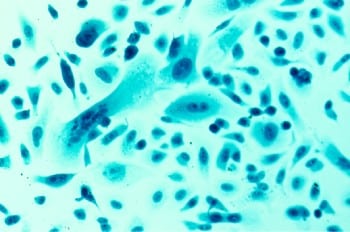Why do bristlecone pines live so dang long? It may be in their DNA

The takeaway: The bristlecone pine tree, which lives in small, scattered pockets around the American Southwest, is among the oldest living things on Earth. Not only are they super old—up to 5,000 years—but they inhabit one of the most extreme topographical corners of the continent and suffer through some of the worst weather on the planet. How can they grow so old? Their DNA may play a prominent role.
Hikers, campers, skiers, and adventurers visiting the remote corners of the American Southwest are often treated to a captivating and memorable sight—stands of gnarled trees perched in some of the most impossible and inaccessible reaches of high mountains, their bark blasted by centuries of heavy weather, their roots exposed and wrapped around cornices of naked granite and hanging perilously along cliff edges and abutting almost directly to treeline.
But what causes these trees to live so long, and how can they seemingly thrive in such contrarian environments? Their DNA may play a role.
What is the oldest tree species on Earth?
The Great Basin bristlecone pine, Pinus longaeva, holds the title as the oldest tree in existence, with a smattering of examples reaching more than 5,000 years, and a current specimen, dubbed Methuselah after the long-lived Biblical patriarch (though he was nowhere near as old as the tree itself) and found in a remote corner of the Sierra Nevada near the California-Nevada border, was found to be more than 4,789 years old thanks to a core sample taken in 1957.
There are three species of bristlecone pine, all of which are found in the Southwest. The Great Basin bristlecone is found in remote, high mountaintops in Utah, Nevada, and eastern California. The Rocky Mountain bristlecone is found in Colorado, New Mexico, and Arizona, and is both the most populous of the three and the most widely cultivated. Finally, the Foxtail pine is found in the Klamath Mountains and in the southern Sierra Nevada and adjacent mountain ranges such as the Spring Mountains north of Las Vegas; the Foxtail pine can be found living adjacent to Great Basin bristlecones in the Spring Mountains and the two are commonly mistaken for each other.
Climate change threatens ancient bristlecone pines
Although bristlecone pine trees have lived for thousands of years, they are proving no match for climate change. In already-arid parts of the Southwest, rising temperatures have prompted rapidly growing populations of beetles that attack the trees—this is impacting not only bristlecones but many species of trees in the west, including giant sequoias in the central and southern Sierra Nevada.
Their disappearance in certain groves has caused alarm among conservationists and researchers, who note the accumulated genetic history in each tree.
“If the specimen had a gene that made it uniquely capable of surviving in that forbidding landscape, there was no chance of resurrecting it,” noted a 2022 article in The Washington Post. “No hope of collecting seeds for replanting or taking a cutting in an attempt to produce clones. No opportunity to draw on the tree’s DNA to help the rest of the species survive.”
Bristlecone pines in the Great Basin: A study of genetic variation
Few genetic studies have looked at bristlecone pine tree DNA in detail, though those that exist provide tantalizing details about the trees.
In a grove of bristlecones in the White Mountains of California, one team of genetic researchers, Johnson and Critchfield, noted a high degree of polymorphism. A separate study, by Hiebert and Hamrick, found normal to high levels of genetic variation in Great Basin bristlecone pines when compared to other pines, in tree populations in both eastern Nevada and western Utah.
As with other species that have relatively small and geographically isolated populations, genetic variation is important for the health of the broad species population. Without genetic variation present, surviving populations with similar genetic makeups can be prone to disease, drought, pests, and more, and face widespread depopulation.
Bristlecone pine tree seeds disperse through the wind, but Clark’s nutcrackers may also play a role in dispersal. The birds bury seeds in caches, which may form a mini forest of clumped trees. Such a method of seed dispersal could impact the trees’ genetic structure and explain their ability to gain a foothold in compromised environments such as recent burn scars. Tests showed that trees growing in clumps as a result of caching by Clark’s nutcrackers have separate genetic identities.
A 2011 study, meanwhile, found that current populations in the Great Basin were defined by restricted gene flow.
“The distribution of genetic diversity and substructuring of P. aristata may be an outcome of a combination of restricted gene flow due to geographic and phenological isolation, random processes of genetic drift, life history traits, natural selection, and postglacial migrations,” the report noted. “The combination of low genetic diversity, moderate population isolation, and a protracted regeneration dynamic puts populations at risk for extirpation by novel stresses.”
Sequencing the bristlecone pine: A research goal
While genetic studies of these ancient trees have been sparse, change may be on the way. One organization, the Vaughn-Jordan Foundation, recently sought applications for DNA genome and transcriptome sequencing of bristlecone pines. The group has made $100,000 available to a part to do the work, with the funds awarded to the Whitebark Pine Ecosystem Foundation.
The organization, which is dedicated to furthering botanical and horticultural science, notes that the age of the trees makes them incredibly important assets in the study of climate change, and that bristlecones are unique in their reproductive behavior: While most organisms see their fertility decrease with age, bristlecones do quite the opposite—the pines know no biological clock.
Unique though they are, the bristlecone pine genome has never been sequenced—a fact that Vaughn-Jordan would like to change. To date, only the loblolly and sugar pines have been sequenced, perhaps because of their commercial value.
The Whitebark Pine Ecosystem Foundation will use whole transcriptome sequencing to generate short read and long read data for bristlecones in the White Mountains as well as a hybrid draft genome and a characterization of methylation profiling for both young and old trees.
What will these studies show, ultimately? As The Washington Post noted, “The secret to their survival is their ability to withstand what others cannot. “Few trees can take a beating like the bristlecone.”






















